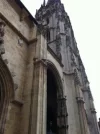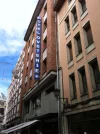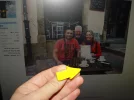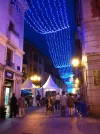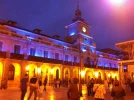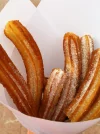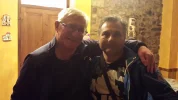Dear Salvador friends, I've finally written down my notes from Camino del Salvador.
Here they are, the walk as I remember it:
Day 1, Leon- Buiza (albergue)
Day 2, Buiza-Pajares (albergue)
Day 3, Pajares-Pola de Lena (albergue)
Day 4, Pola de Lena- Mieres (albergue)
Day 5, Mieres- Oviedo. (Hotel)
I used both the csj (Lauries guide book) and the spanish book: Guide to Camino del Salvador (with the photos):
http://caminodelsalvador.net/
Day 1. From Leon to Buiza. The camino starts with maybe 7 km pavement walking out of Leon. After that, a trail through the woods where there were extremely many flying bugs. I thought it was best to run through it, but wished I had a mosquito net on my hat (will bring that the next time). Later there was some asphalt road walking before and after the big power plant: after Cascantes and before La Robla. Had some difficulties finding the way here. Here one has to walk on a busy asphalt road for a while, lots of cars. I passed La Robla (the way through was easy) and at the end of the town was the Albergue. ( I did not stop) After this, you continue to walk on pink and white pavement out of town. I was a bit confused here as the spanish guide book said we walk on a beautiful path along the river. The river is further on and it's pavement a long way. At Puente de Alba I was lost for a while, as there were three roads to chose from. The right one is the camino, but the way marking is 100-200 m up the hill and you have to walk there to see it. After that it was fairly easy to find the way to Pola de Gordon. Here I tried to find a hotel but when I arrived everything I saw was closed. I already had food in my pack and decided to continue to Buiza (where there are no shops). The last part of that walk was mostly on one narrow asphalt road, with only one way marking as you enter it, then nothing until Buiza. In Buiza the albergue is on the right side of the road, easy to find. It's big, clean and has a kitchen and good hot shower (one bathroom for men, one for women).
Lots of water fountains along the way.
Day 2. To Pajares.
Leaving Buiza and then uphills to the mountains. (I did not walk the n -630 option) The trail was easy to follow, and the way marking was very good. I walked in sandals and had no problems. In Poladura de la Tercia I had hoped to find something to eat, but there was nothing that day, not even an open bar. The albergue is very basic, according to my companion who went there for a look. He had planned to stay at the casa rural, but as they did not serve any food or coffee (they only had cold drinks and peanuts) until the evening, he decided to move on also.
Walked to Arbas. The restaurant there (or bar, or what it was) was closed and for sale. From there we walked on the n-630 to the bar at Puerto de Pajares, which was open, lots of people there. Good menu del dia. After that a walk to Pajares, which was longer than I expected. The albergue was at the left side of n-630. The albergue was ok, one bathroom for both men and women. There was a bar in town, it was open when I entered town, then it closed, they said it should open in the evening at 20.30, don't know if it did. We were four staying at the albergue, and I thought one could eat at there, but there was only the coffee and snack machine. I was glad I had some food in my pack.
Day 3. To Pola de Lena.
The most difficult day. The bar in Pajares was closed for holiday. Thanks to the coffee and snack machine in the albergue there was at least something for breakfast. The walk starts with a walk down a very steep road. It was so steep my legs were shaking when we got down. The way was easy to find, but I didn't know it would be so hilly. You pass through a few small villages. Before Puente los Fierros one can chose to turn left through the woods, or continue to walk on the road, we took the way through the woods. Lots of ups and downs and lots of blackberries growing on the trail. This part was much longer than I expected and no bar or shop anywhere. Before Campomanes there was another very steep downhills, again very hard for the legs. Should you walk it uphills, you would probably rather climb it, using your hands too. In Campomanes we were incredibly happy to find an open bar, finally. We wanted to stop but all hotels in town were fully booked, occupied by workers. A man drove us to the police station (!) in Pola de Lena, where they showed us the way to the albergue, which was big, clean with a large bathroom. My walking companion had to go to the hospital in town, which was easy, no long waiting. We found a good restaurant and a nice bakery in the town also, not far from the albergue.
Day 4. To Mieres.
From here there was no need to carry lots of food as there were bars and shops in many places.
We took half day off, first in Pola de Lena, and later the train back to Christina de Lena ( The church is very small but beautiful, and it was open) from where we walked back again to Pola de Lena. To here it was most flat asphalt walking. It was difficult to find the way through town (had to use GPS, Google maps and ask the locals). After we finally made it, it was road walking and asphalt paths most of the day to Mieres, very tiring for the feet. We stopped in Ujo where we went to the nice bakery next to the church. When in Mieres, you must walk through the whole city, the albergue is outside town at the other side. We got lost again and had to ask the locals. The albergue was ok, but too many beds in one room, very little space between, and you could not open the windows. Good separate bathrooms and a hot shower. A small kitchen. We bought food in a little shop about 100-200 m from the albergue.
Day 5. To Oviedo.
First a long uphills on asphalt. Then a mix of road walking and nice trails in the woods. This day was nothing special, not too hard, a few hills up and down. You pass a few towns/little villages where the were bars. Some nice views as you come closer to Oviedo.
Summary:
* there were more asphalt road walking than I had expected, and many of these roads are narrow with steel fences and/or no shoulder. I used a hi-viz every day and was glad I did.
* The waymarking was good in most places, but I got lost a few times as mentioned earlier. My walking companion had a GPS which was very helpful. I also used google maps on my iPhone.
* 3G was no problem, there were more 3G than no-3G. There were also wifi in a few bars, but not everywhere.
* water was no problem, there were fountains along the way. On day two there were less fountains as you walked in the mountains, but still no problem, I thought. I carried two 1/2 liter bottles, one full and one half full "just in case".
* food was a problem as there were no shops and just a few bars from Poladura to Campomanes. I carried lots of extra food.
* I had a light sleeping bag and used blankets too. It was a bit chilly in Buiza and Pajares.
* I had an electric coil (and a mug) with me too cook water for tea, which I used every day. You could probably cook water in the kitchens in the albergues but I wasn't sure about if there were pots and pans etc. An essential item as tea made of microwave cooked water is undrinkable.
* I walked in sandals and my pack was 4,5 kg before food and water, which felt right for me. My walking companion had heavy leather Goretex boots and carried 13 kg in his pack, and was happy with that. It was a little bit colder on top of the mountains, but not as bad as I feared. We both had trekking poles which were great, as you sometimes walk in the terrain.
* The best part is between Buiza and Pajares, I think. That part is the best walk I have ever done.





